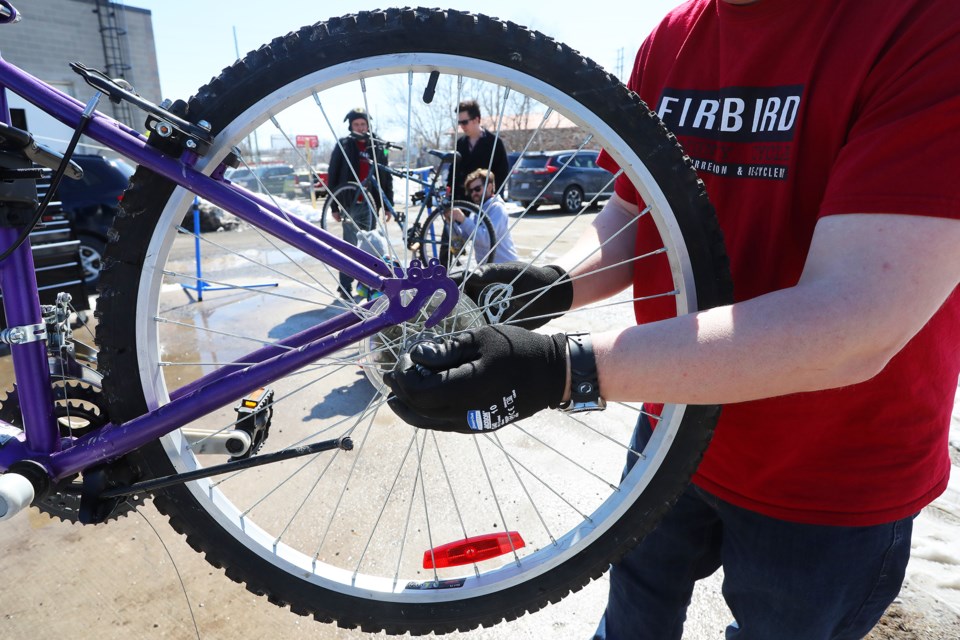Pleas from residents to use gas-tax funding on creating more bikes lanes in the city fell flat this week at Barrie council.
The city recently came into $8.6 million in federal gas-tax funding, the vast majority will go toward road resurfacing, including almost $3.5 million for work on Dunlop Street West, as well as $400,000 for a waterfront wifi project, $300,000 to traffic-calming measures and active transportation, and $200,000 in tennis court rehabilitation.
Three people made last-minute deputations Monday night urging council to spend more money on the city's active transportation infrastructure. In the end, council opted to stick to the funding allocation as initially approved at general committee.
Robb Meier, a longtime advocate for cycling in the city, said the money would be better spent on "much-needed" bike lanes and related infrastructure than allowing someone to live-stream at the waterfront.
"I've never been laying on a beach here, in Cuba or elsewhere and wishing I could catch up on the latest episode of Game of Thrones. Who does? Wifi and tennis are, quite frankly, luxury items a municipality shouldn't be spending money on," Meier said.
That money would be better spent being invested in roads and making them safer, he said, adding progress in getting people out of cars and into active transportation is a decade behind in Barrie.
Meier called for more investment in the coming years for "a real, connected network of on-street bike lanes that all members of our great community can feel safe on and make the choice to use," including seniors, which he says will be a major growth area for the bicycle use.
Meier also noted the design for the new Essa Road overpass will not include bike lanes underneath as part of Highway 400 widening. He urged that the same mistake not be made with similar work at the Dunlop Street crossing.
In another deputation to council, Judy Morozuk says her choice to make active transportation "the centre of my lifestyle" has instilled "a deep sense of community."
Money she saves on not having a car payment is spent in downtown shops.
"Businesses depend on regulars and this lifestyle choice is an important way to me to contribute to the vibrant business community here in Barrie," Morozuk said. "And yet, I feel marginalized."
Morozuk said her co-workers always ask whether she rode her bike to work.
"It is just so weird to me that I'm weird for riding my bike in Barrie," she said. "It's not a novelty to me; it's the way I get around."
The city needs to do more to create a safe cycling network, Morozuk said, adding council's choice to spend the gas-tax funding on things like tennis courts and waterfront wifi was "disheartening" as an avid cyclist.
Morozuk offered to take councillors around for a ride around the city to explain why more people aren't using bike lanes. Primarily, she said city pathways and bike lanes are disconnected.
"Woman are terrified to ride, overwhelmingly. I know this because I talk to them all the time," she added.
Morozuk called for more sustained funding to create a better cycling network.
"Sharing the road is cultural, but it's also influenced by the infrastructure that signals reminders to drivers and also promotes that much-needed sense of security for the people who want to ride their bikes, for joy or for transportation choice," she said.
Architect Andy Thomson said he moved his family to Barrie from the Toronto area two years ago after being "struck by this sensational planning that was undertaken at the waterfront, as well as areas like Sunnidale and the downtown core," he said.
However, the father of three said, "we've discovered it's not exactly the safest place we've lived for active transportation measures, because the kind of planning at the waterfront doesn't extend into the neighbourhoods of Barrie," Thomson said. "Even if Sunnidale (Road) and Anne (Street) were bikable, that would be a huge stretch in the right direction."
With a substantial population boom in the near future, Thomson said investment in cycling inafrastructure could help Barrie become "a world-class city."
"I tend to agree that we're not doing enough," said Mayor Jeff Lehman. "I'm hoping that, as we move forward from this point, we can start to (do more), because there were some valid points made in the deputations.
"We don't have a great cycling network," the mayor added. "There's still lots to do. We don't take the opportunity to make it easier to walk around the city, everywhere from the site-plan level to subdivision design."
Lehman said he hopes it's a matter that can be addressed more as the south end is built out.
Lehman agreed that it will take more than gas-tax funding to improve the city's cycling infrastructure, as it needs to be done on a yearly basis.
"This is something that we're increasingly hearing from throughout the community more broadly," he said. "Regardless of outcome of this motion, whether the increase is enough and obviously not for some, it is at least a message that we've all received around this table."
While council chose not to change the gas-tax allocation, Coun. Natalie Harris said active transportation could be looked at more closely in the staff report later this month.


